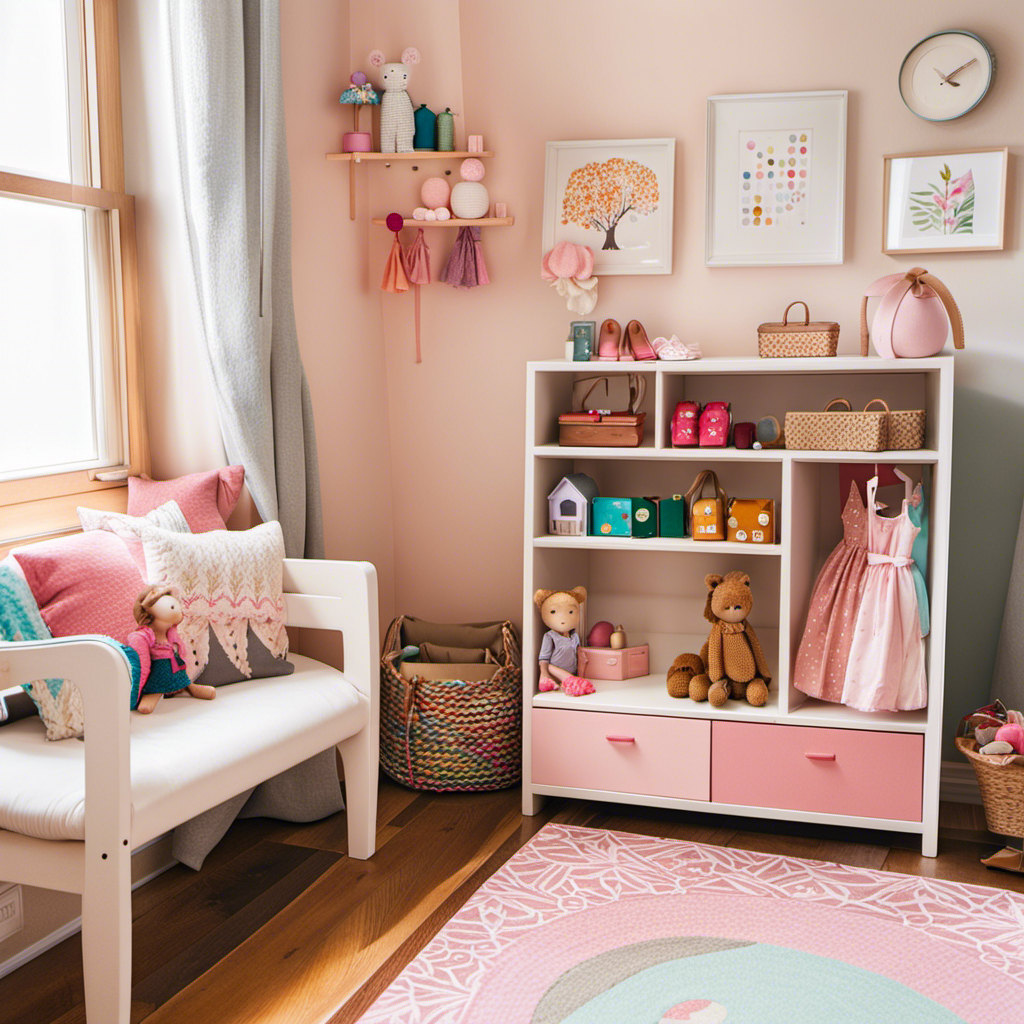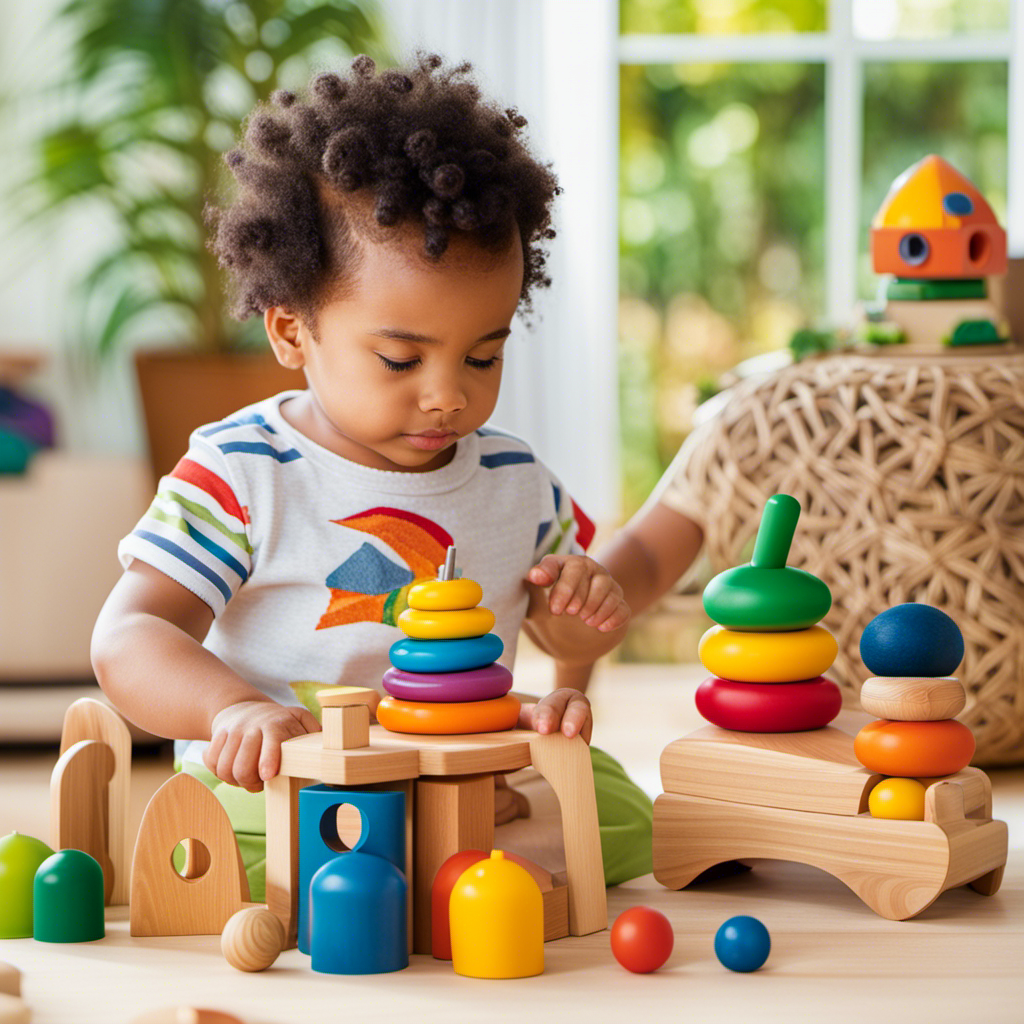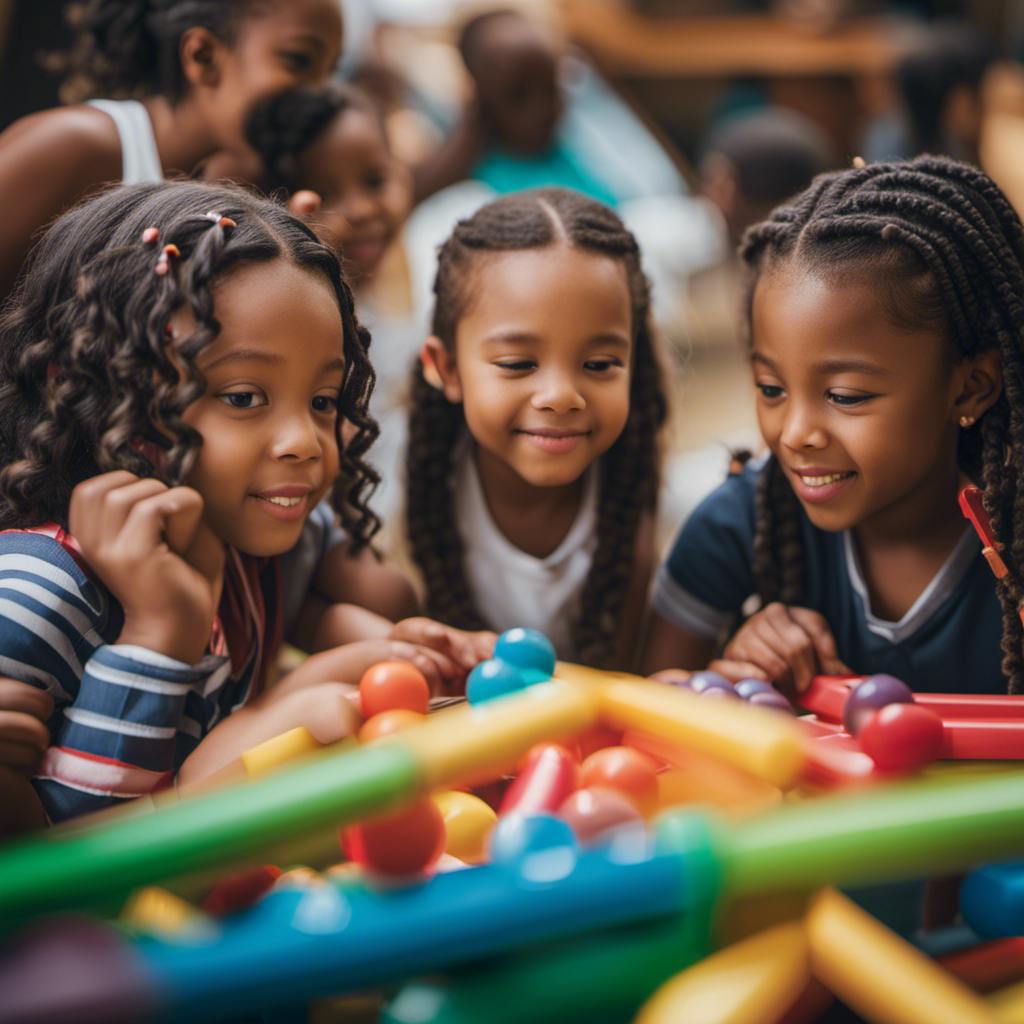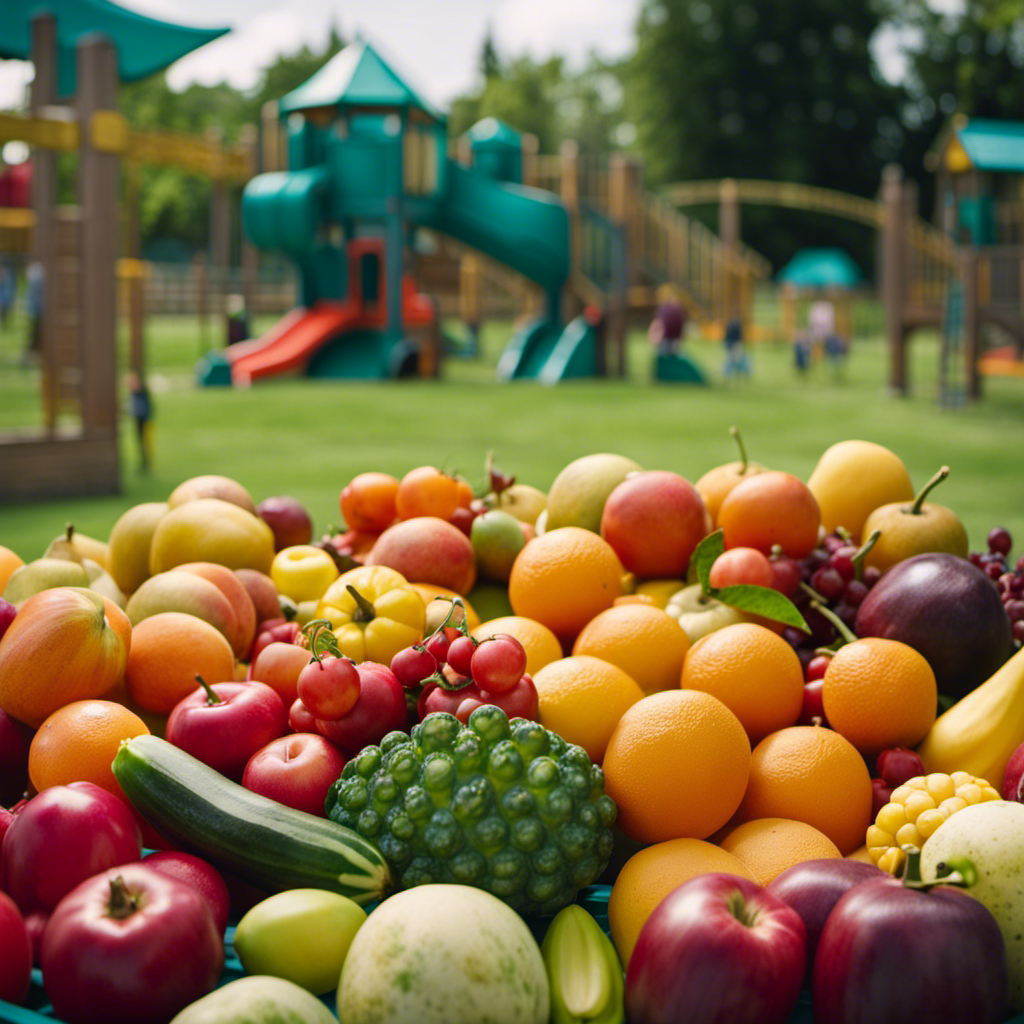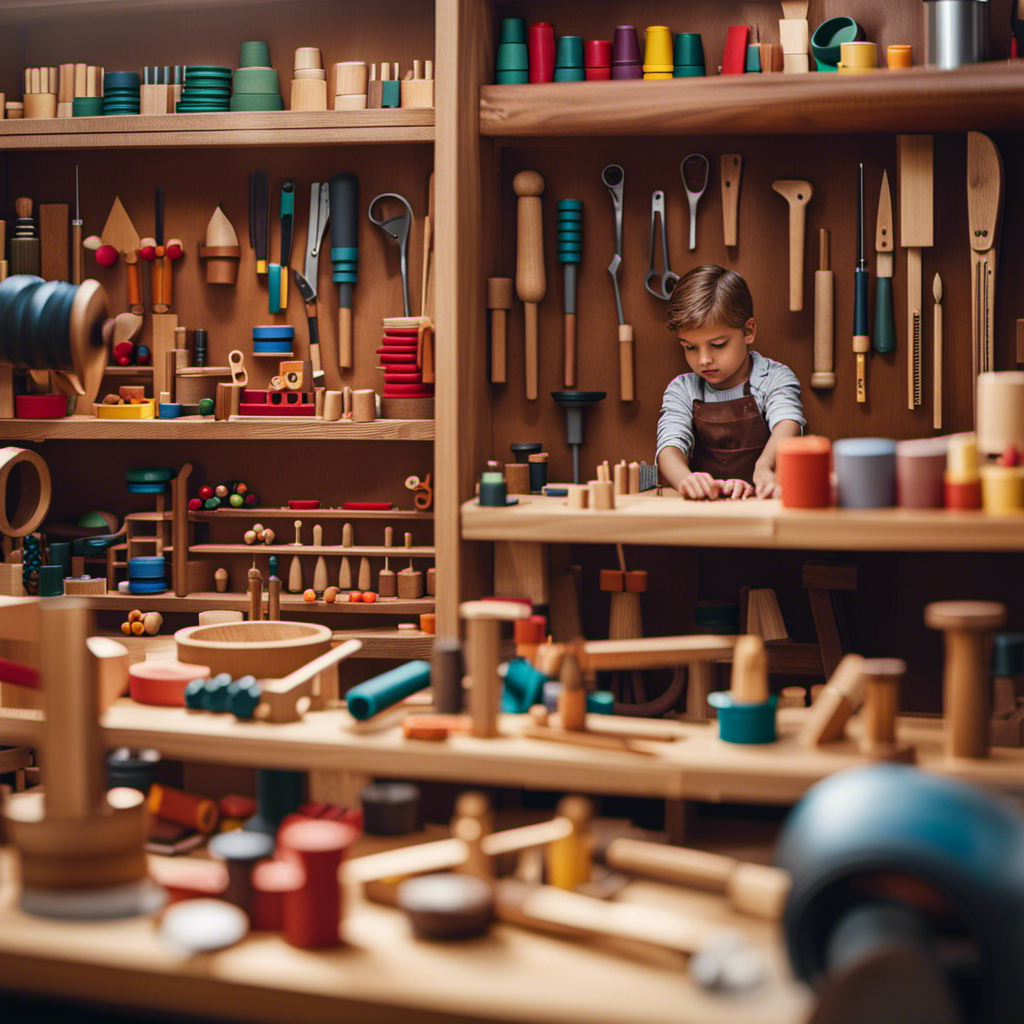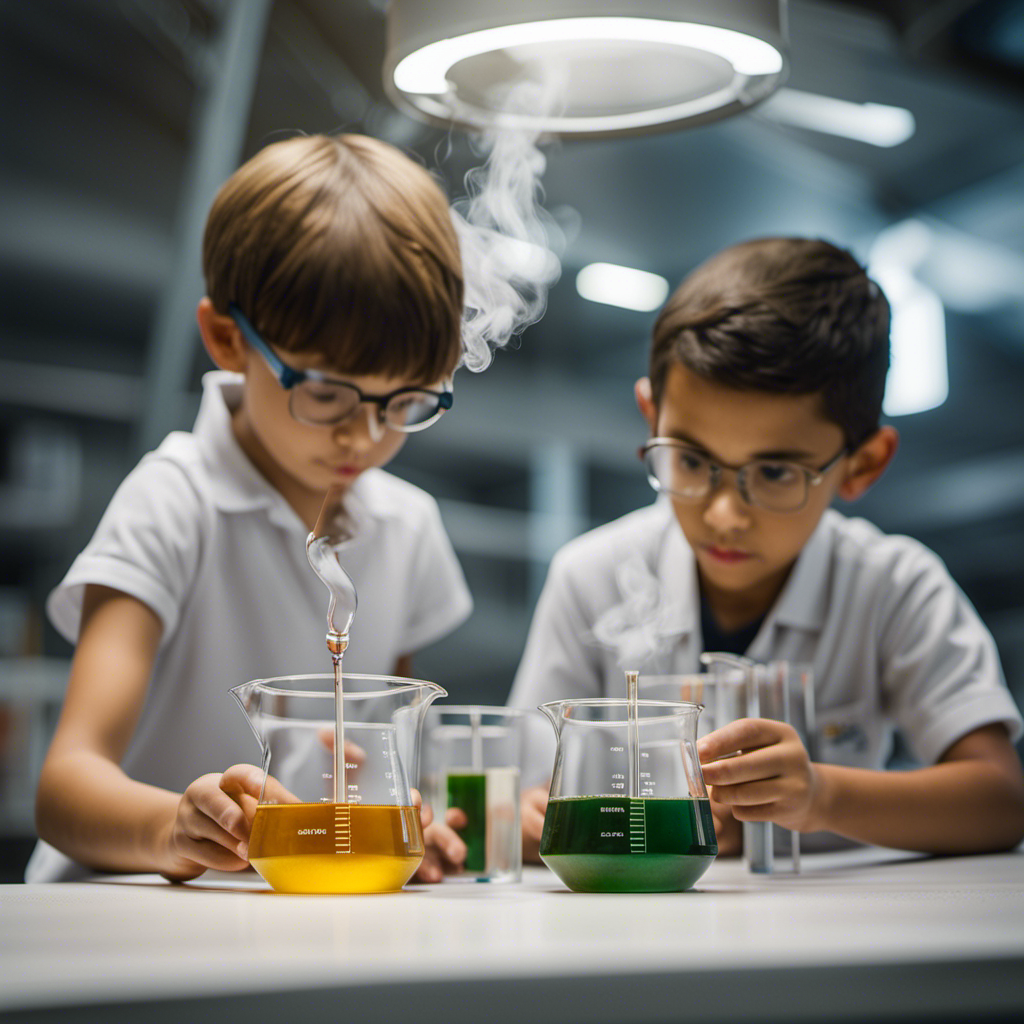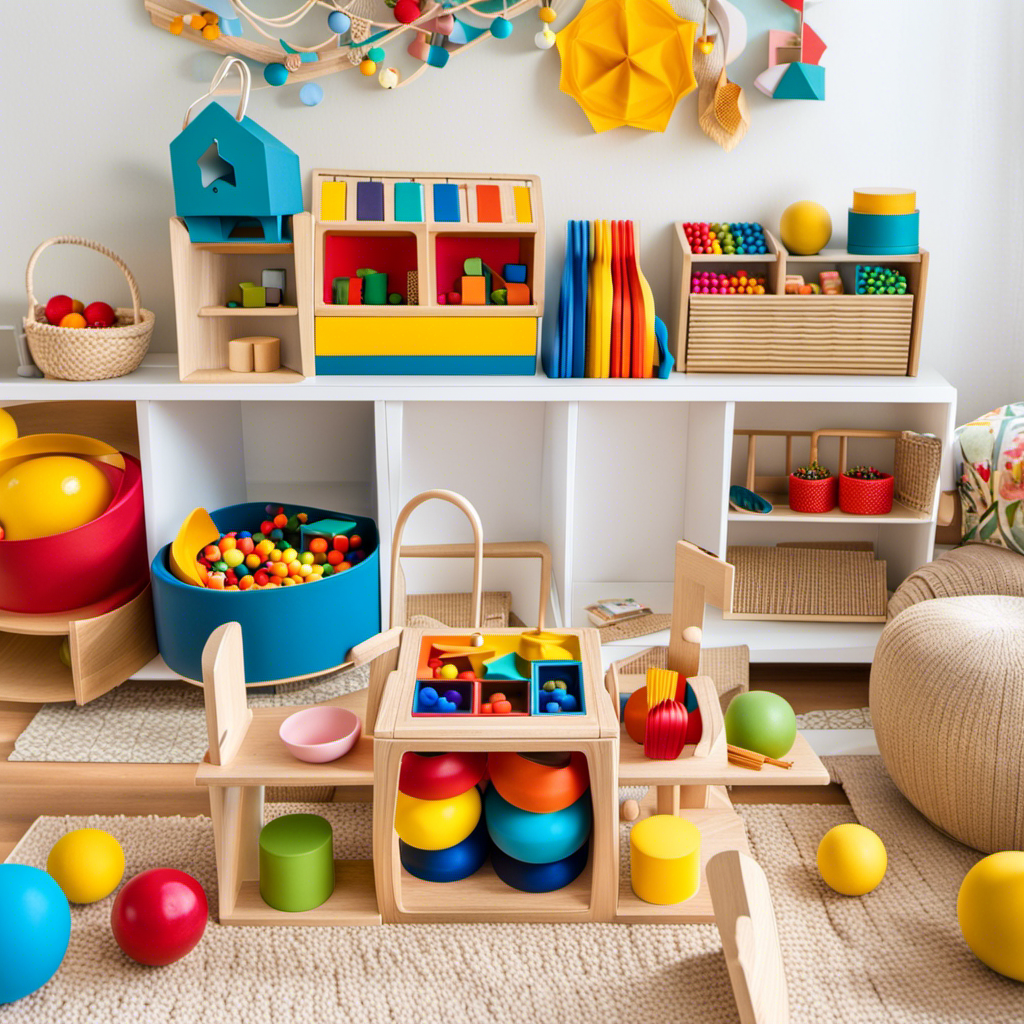Preschool Toys
What Toys to Avoid With Preschool Age Children
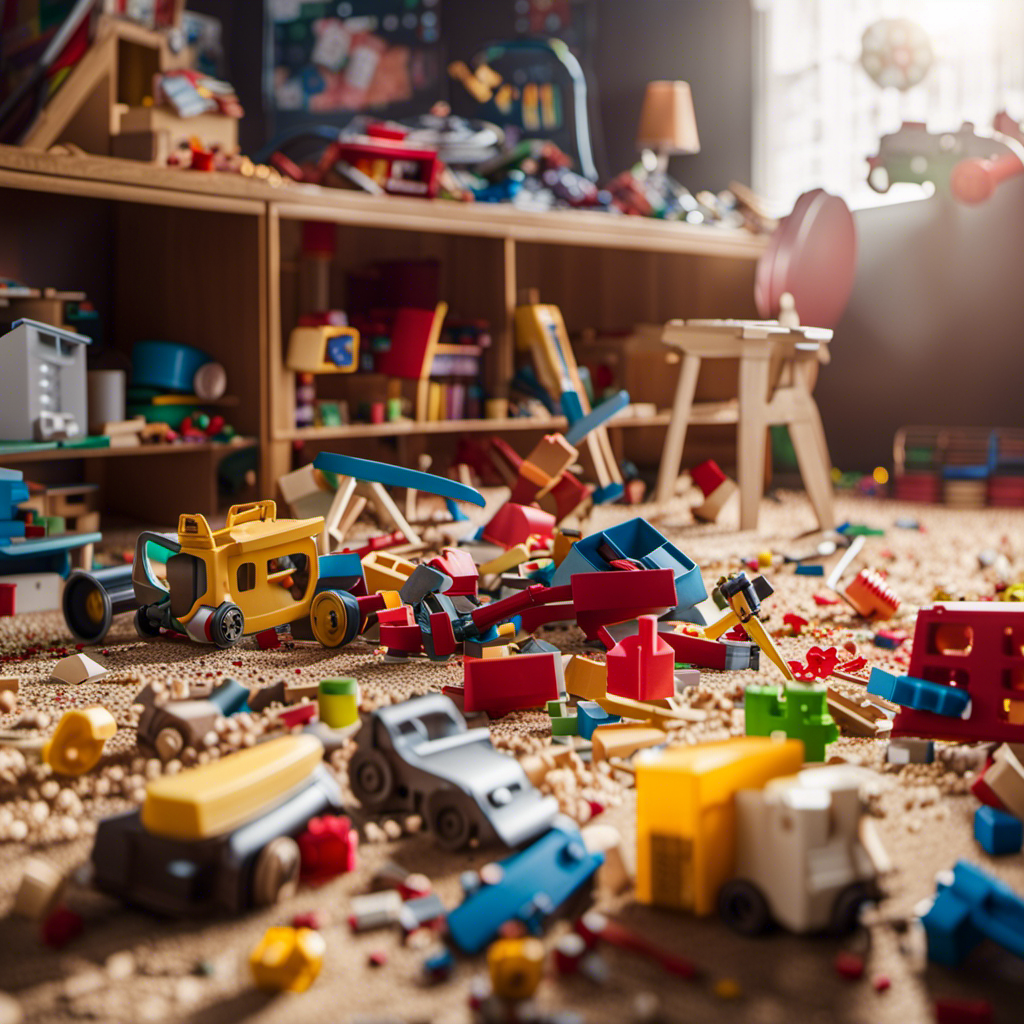
As a parent, I recognize the vital significance of choosing toys that are safe and appropriate for my preschool-aged child. The wide range of options on the market can make it difficult to navigate. That’s why I aim to share my expertise to help you make informed decisions.
In this article, I will discuss the toys that you should avoid when it comes to preschoolers. From choking hazards to toxic materials, I will provide you with detailed information to ensure your child’s safety.
Let’s dive in and learn what toys to steer clear of!
Key Takeaways
- Avoid small toys or objects that can be swallowed
- Choose toys made from safe and non-toxic materials
- Select toys with soft and rounded edges
- Be cautious of strings, cords, and batteries
Choking Hazards
Make sure to steer clear of any small toys or objects that could pose a choking hazard for preschool age children. When it comes to age appropriate toy selection, safety should always be a top priority. Preschoolers have a tendency to explore and put objects in their mouths, so it is crucial to provide them with toys that are specifically designed for their age group.
One major safety hazard to be aware of is batteries. Many toys nowadays come with small button batteries that can easily be swallowed by young children. If ingested, these batteries can cause serious injuries, such as burns or even death. It is important to always check the battery compartments of toys and ensure they are securely closed. Additionally, be cautious of toys that have loose or easily removable parts that could become choking hazards.
Transitioning into the next section about ‘toxic materials,’ it is important to not only consider the size of the toy but also the materials it is made from. Some toys may contain toxic substances such as lead or phthalates, which can be harmful if ingested or absorbed through the skin. It is crucial to read labels and choose toys that are made from safe and non-toxic materials.
Toxic Materials
There’s a risk of exposing young kids to toxic materials when playing with certain toys. One of the biggest concerns in recent years has been toy recalls due to lead poisoning. Lead is a highly toxic metal that can cause serious health problems, especially in children. It can affect their brain development, leading to learning disabilities, behavior problems, and even death in extreme cases.
Toy recalls happen when a product is found to have exceeded the acceptable levels of lead. These recalls serve as a reminder to parents and caregivers to be vigilant when choosing toys for their children. It’s essential to carefully read labels and look for toys that are labeled as lead-free or have undergone thorough testing for safety.
In addition to lead, other toxic materials like phthalates, bisphenol A (BPA), and formaldehyde have also been found in some toys. These chemicals can have harmful effects on children’s health, including hormone disruption, respiratory issues, and even cancer.
To ensure the safety of our children, it’s crucial to stay informed about toy recalls and choose toys that adhere to safety standards.
In the next section, we’ll discuss another important aspect to consider when selecting toys for preschool age children: small parts.
Small Parts
When selecting toys, it’s important to be aware of small parts that could pose a choking hazard. As a parent, I understand the importance of keeping my preschool-age child safe while still providing them with fun and engaging toys. Here are a few things to keep in mind when it comes to small parts and choking hazards:
-
Age-appropriate toys: Always check the recommended age range on the packaging of the toy. This will give you a good indication of whether the toy contains small parts that could be dangerous for your child.
-
Inspect for small parts: Before giving a toy to your child, take a close look at it. Look for any small detachable parts that could easily come off and be swallowed. If you find any, remove them or choose a different toy.
-
Consider the size: Even if a toy doesn’t have small parts, be mindful of the overall size. Toys that are too small can still pose a choking hazard, especially for younger children who tend to put things in their mouths.
Transitioning to the next section about ‘sharp edges’, it’s also important to be aware of potential hazards beyond choking.
Sharp Edges
When it comes to selecting toys for children, safety should always be a top priority. Understanding and following safety standards for toys is crucial to ensure that the toys we choose are free from any potential hazards.
Age-appropriate toy selection is also important, as it helps to ensure that the toys are suitable for a child’s developmental stage and abilities.
Additionally, toys with soft and rounded edges are recommended to minimize the risk of injuries, especially for younger children who are more prone to accidents.
Safety Standards for Toys
To ensure the safety of your preschool age children, it is important to choose toys that meet the necessary safety standards. Toy manufacturing regulations are in place to ensure that toys are designed and manufactured with safety in mind. These regulations cover aspects such as the use of non-toxic materials, absence of sharp edges, and proper construction.
When purchasing toys for your preschoolers, it is important to check for labels or markings that indicate compliance with these regulations. This will give you peace of mind knowing that the toys you are buying have met the necessary safety standards.
However, even if a toy meets all safety standards, accidents can still occur. That’s why supervision plays a crucial role in ensuring the safety of your children while playing with toys. It is important to always keep a watchful eye on your child during playtime.
Now, let’s move on to the next section and discuss the importance of selecting age-appropriate toys for your preschool age children.
Age-Appropriate Toy Selection
It’s important to choose toys that are appropriate for your child’s developmental stage. Ensuring that the toys you provide are suitable for their age can greatly enhance their growth and learning. Here are some key considerations for age-appropriate toy selection:
-
Safety: Look for toys that meet safety standards and have passed rigorous testing to ensure they are free from harmful chemicals and choking hazards.
-
Cognitive Development: Toys that encourage problem-solving, creativity, and imagination are ideal for preschool-age children.
-
Physical Development: Choose toys that promote fine motor skills, hand-eye coordination, and balance, such as building blocks or puzzles.
-
Social Skills: Toys that foster cooperation, sharing, and communication can help children develop important social skills.
When selecting age-appropriate toys, be sure to consider reputable brands that specialize in creating educational and engaging toys for children of different age groups.
Now, let’s explore the importance of toys with soft and rounded edges.
Soft and Rounded Edges
Soft and rounded edges are important for ensuring the safety of young kids while playing with toys. Childproofing is essential to protect children from potential hazards, and one way to do this is by selecting toys with soft and rounded edges. These types of toys minimize the risk of injuries, such as cuts or bruises, especially for preschool age children who are still developing their motor skills.
However, even with childproofing measures in place, supervision is crucial when children are playing with toys. Parents and caregivers should always keep a watchful eye to ensure that children are using toys appropriately and safely. By providing a safe environment and close supervision, we can help prevent accidents and promote a positive play experience for children.
Speaking of safety, let’s now move on to discussing the potential dangers associated with strings and cords.
Strings and Cords
Strings and cords can pose a choking hazard for preschool age children. It is essential to ensure that play materials and toys for this age group are safe and free from any potential risks. Here are some important points to consider when it comes to strings and cords:
-
Tangle free options: Look for toys that have tangle-free strings or cords. This reduces the risk of entanglement and strangulation accidents.
-
Alternative play materials: Instead of toys with strings or cords, consider alternatives such as cloth or fabric toys, which are safer for young children. These toys provide tactile stimulation and encourage imaginative play without the risk of choking or strangulation.
-
Supervision: Even with tangle-free options, it is crucial to supervise young children while they play with any toys that have strings or cords. This ensures their safety and allows you to intervene if any potential hazards arise.
-
Regular checks: Regularly inspect toys for any signs of wear and tear, especially in the strings or cords. If you notice any fraying or damage, it is essential to replace the toy or repair it promptly to avoid any accidents.
When it comes to toy safety, strings and cords are just one aspect to consider. Another important area of concern is batteries and electrical toys, which I will discuss in the next section.
Batteries and Electrical Toys
As a parent, it is important to be aware of the safety hazards posed by batteries and electrical toys.
Batteries can be a choking hazard if swallowed, and can also cause burns or chemical injuries if mishandled.
When choosing electrical toys, it is crucial to consider the age appropriateness and ensure that they are suitable for your child’s developmental stage to minimize the risk of accidents or injuries.
Safety Hazards of Batteries
Make sure you don’t let your preschooler play with toys that have loose or easily removable batteries, as they can be a safety hazard. Here are four reasons why these batteries can pose potential fire hazards and the importance of proper battery storage:
-
Choking Hazard: Loose batteries are small and can easily be swallowed by curious preschoolers, leading to choking incidents.
-
Short Circuit: If a loose battery comes into contact with metal objects, it can create a short circuit, potentially causing sparks or even a fire.
-
Chemical Leakage: Damaged batteries can leak corrosive chemicals, which can be harmful if ingested or come into contact with the skin.
-
Battery Overheating: Improperly stored or loose batteries can overheat, leading to a fire risk.
Ensuring proper battery storage, such as keeping batteries in a secure container, can greatly reduce these safety risks.
Now, let’s move on to age-appropriate electrical toys.
Age-Appropriate Electrical Toys
Now that we understand the safety hazards of batteries, let’s talk about age-appropriate electrical toys for preschoolers.
It’s important to choose toys that are suitable for their age and developmental stage. Age-appropriate battery-operated toys are designed with safety in mind, ensuring that the electrical components are securely enclosed and inaccessible to little hands. These toys often have larger buttons or switches that are easy for preschoolers to operate.
When selecting these toys, it’s crucial to look for the age recommendation on the packaging to ensure it aligns with your child’s abilities and understanding. Additionally, always supervise your child while they play with electrical toys to prevent any accidents.
Now that we’ve covered electrical safety, let’s move on to another potential hazard: choking risks.
Potential Choking Risks
Always be mindful of small objects that could pose a choking hazard to your little ones. When it comes to toys, safety should always be a top priority. One important aspect to consider is the presence of toxic materials in toys. It is crucial to ensure that the toys your child plays with are free from harmful substances such as lead or phthalates. Look for toys that meet safety standards, such as those labeled with the ASTM F963 symbol, indicating compliance with federal regulations.
Additionally, be cautious of toys with small parts that could easily detach and become a choking hazard. Always double-check the age appropriateness of toys and supervise playtime to prevent accidents.
Now, let’s move on to another potential hazard: projectile toys.
Projectile Toys
Avoid giving your preschooler projectile toys like dart guns or slingshots. These toys may seem fun and exciting, but they can pose a risk of injury to young children. Instead, consider alternative toys that promote safe play and creativity. One great alternative is foam ball launchers. These toys allow children to engage in active play without the risk of injury. Foam ball launchers are designed with safety in mind. The balls are soft and lightweight, reducing the chances of accidents. Another option is frisbees or soft flying discs. These toys can be thrown and caught, encouraging hand-eye coordination and gross motor skills development.
When it comes to safe play guidelines, it’s important to supervise your child during playtime. Teach them to never aim the toys at people or animals, and to always play in an open area away from breakable objects. Additionally, make sure to set boundaries and establish clear rules for safe play. By following these guidelines, you can ensure that your child has a fun and safe play experience.
Now, let’s move on to the next topic: toys with loud noises.
Toys With Loud Noises
When playing with toys that produce loud noises, it’s important to consider the impact on your child’s hearing. Excessive exposure to loud noises can lead to hearing loss or damage in young children. As a parent, it is crucial to choose toys that prioritize your child’s safety and well-being.
Toys that produce loud noises can be exciting for children, but it’s important to find a balance between fun and safety. Here is a table that highlights the potential risks and precautions associated with toys that produce loud noises:
| Risk | Precautions |
|---|---|
| Hearing damage | Limit the amount of time your child spends playing with these toys. Use ear protection, such as earmuffs or earplugs. |
| Disturbance | Consider the noise level in your home and the impact on others. Choose toys with adjustable volume settings. |
| Startling effect | Introduce these toys gradually to help your child adjust to the loud noises. Monitor their reaction and provide reassurance if needed. |
It’s also important to be aware of choking hazards associated with toys that produce loud noises. Ensure that the toys are age-appropriate and do not contain small parts that could be swallowed or inhaled.
Transitioning into the subsequent section about toys with complex assembly, it’s crucial to consider the safety aspects and age appropriateness when choosing toys for your child.
Toys With Complex Assembly
To ensure a successful assembly experience, it’s important for you to carefully follow the instructions provided with toys that have complex assembly.
These toys can provide hours of fun and learning for your child, but they also come with potential choking risks if not assembled correctly.
Here are some important points to keep in mind when dealing with toys that require complex assembly:
-
Read the instructions thoroughly: Take the time to read through the instructions before starting the assembly process. This will give you a better understanding of the steps involved and any safety precautions that need to be taken.
-
Use the right tools: Make sure you have all the necessary tools before starting the assembly. Using the wrong tools can lead to improper assembly and potential hazards.
-
Check for loose parts: Before giving the toy to your child, double-check that all parts are securely attached. Loose parts can pose a choking risk, so it’s essential to ensure everything is properly secured.
-
Store small parts safely: If the toy contains small parts that are not meant for children under a certain age, make sure to store them safely out of reach when the toy is not in use.
-
Regularly inspect the toy: As your child plays with the toy, regularly inspect it for any loose or damaged parts. Repair or replace any damaged components to maintain the toy’s safety.
Frequently Asked Questions
Are There Any Specific Toys That Are Recommended for Preschool Age Children?
When it comes to toys for preschool age children, there are definitely some recommendations.
Sensory toys, like playdough or textured balls, can help with their development and exploration.
Creative and imaginative play toys, such as building blocks or dress-up costumes, encourage their creativity and problem-solving skills.
These types of toys provide a lot of benefits to preschoolers.
They can enhance their cognitive abilities, fine motor skills, and social interactions.
It’s important to choose toys that are age-appropriate and safe for them to play with.
How Can I Ensure the Toys I Purchase for My Preschooler Are Safe?
To ensure the toys I purchase for my preschooler are safe, I need to be proactive in checking for toy recalls. I can do this by regularly visiting the Consumer Product Safety Commission’s website or signing up for their email notifications.
Additionally, it’s important to choose age-appropriate toys that match my child’s developmental abilities. I can refer to the recommended age range on the packaging or consult the toy’s manufacturer for further guidance.
Are There Any Specific Warning Signs to Look Out for When Buying Toys for Preschoolers?
When buying toys for preschoolers, it’s crucial to be aware of warning signs that indicate potential safety issues. Look out for small parts that could be choking hazards, sharp edges that could cause injuries, and toxic materials that could be harmful if ingested.
It’s important to ensure toy safety by checking for age-appropriate labels, reading product reviews, and inspecting toys for any potential hazards. By being cautious and informed, you can make sure your preschooler’s playtime is both fun and safe.
Are There Any Safety Regulations or Standards That Toys for Preschoolers Must Meet?
Safety regulations and toy standards are crucial when it comes to toys for preschoolers. These regulations ensure that toys are designed and manufactured with the safety of young children in mind. They cover aspects such as the use of non-toxic materials, durability, and size to prevent choking hazards.
Compliance with these regulations is important to ensure that the toys we give to preschoolers are safe and suitable for their age group.
What Should I Do if I Suspect a Toy My Preschooler Is Playing With Is Unsafe?
If I suspect a toy my preschooler is playing with is unsafe, there are a few steps I can take.
First, I should remove the toy from their reach immediately.
Then, I should carefully inspect the toy for any potential hazards or defects.
If I find any safety concerns, I should report them to the appropriate authorities or the toy manufacturer.
Additionally, I can educate my preschooler about toy safety by teaching them to avoid putting small objects in their mouths and to play with toys in a safe and responsible manner.
Conclusion
In conclusion, when it comes to choosing toys for preschool age children, it’s crucial to prioritize their safety. Avoiding toys with choking hazards, toxic materials, small parts, sharp edges, strings and cords, batteries and electrical components, projectile toys, toys with loud noises, and toys with complex assembly is essential.
Just like a wise captain steering a ship through treacherous waters, we must navigate the toy aisle with caution. Ensuring that our little ones are protected from any potential harm.
Tina is the heart and soul behind Toddler Ride On Toys. With a passion for early childhood education and a deep understanding of child development, Tina ensures that every piece of content on our website reflects our commitment to playful learning. Her expertise in Montessori, Preschool, STEM, and Waldorf education philosophies helps shape our website into a valuable resource for parents, caregivers, and educators.
Preschool Toys
The Top 10 Preschool Toys Every Kid Should Experience!
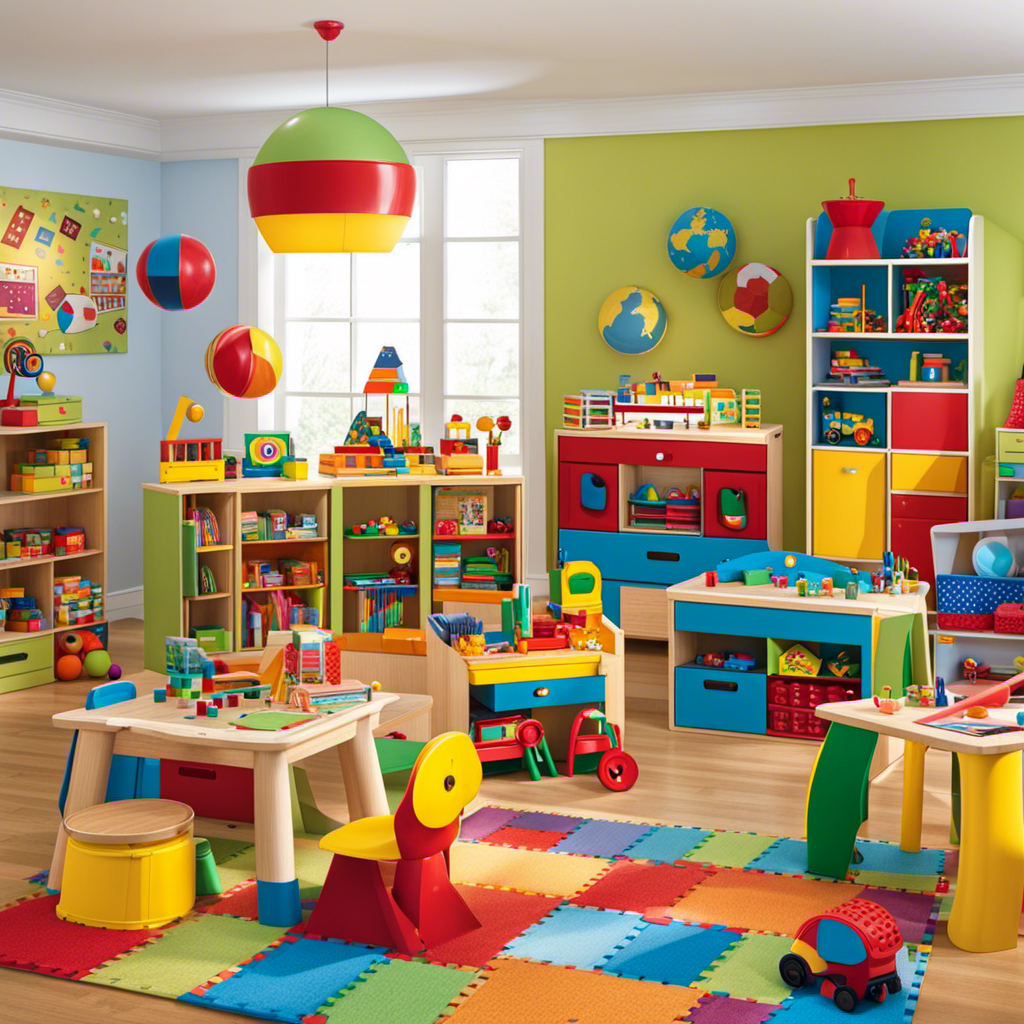
As a parent, I recognize the importance of providing our young children with the best tools for their education and development. That’s why I’ve put together a list of the top 10 toys for preschoolers that every child should have the opportunity to enjoy!
From building blocks to musical instruments, these toys are not only fun, but also promote creativity, problem-solving skills, and imagination.
So, let’s dive in and explore the wonderful world of preschool toys that will captivate and engage our children’s minds.
Key Takeaways
- Building and construction toys, such as block sets, foster creativity and imagination while also building fine motor skills and hand-eye coordination.
- Creative and imaginative play, such as puzzles and play kitchen sets, enhance cognitive development and spatial awareness, promote problem-solving and organization skills, and encourage social interaction and teamwork.
- Dress-up clothes allow children to transform into different characters or professions, encouraging pretend play and role-playing games while also developing social and emotional skills, building confidence, and enhancing imagination and creativity.
- Musical education and instruments offer numerous benefits, including enhancing cognitive abilities, promoting social and emotional development, improving language skills and memory, and stimulating different parts of the brain. Additionally, certain instruments like mini pianos, xylophones, drum sets, maracas, and rainmakers are particularly suitable for toddlers, enhancing their fine motor skills, hand-eye coordination, rhythm, creativity, auditory senses, and gross motor skills.
Block Sets
You should check out the block sets that are available for preschoolers! These sets come in a variety of different block materials, such as wooden, plastic, and foam. They are perfect for fostering creativity and imagination in young children.
With these blocks, kids can build all sorts of imaginative creations, from towering castles to bustling cities. They can experiment with different shapes, sizes, and colors, learning important concepts like balance and spatial awareness along the way. Building with blocks also helps develop fine motor skills and hand-eye coordination.
As children stack, sort, and arrange the blocks, they are engaging in a hands-on learning experience that promotes problem-solving and critical thinking.
Now, let’s move on to the next section about puzzles, where kids can continue to explore and challenge their minds.
Puzzles
Puzzles can provide hours of entertainment and help develop problem-solving skills. They are a fantastic way to engage children’s minds and encourage critical thinking. Here are some reasons why puzzles are beneficial for kids:
- Puzzles promote cognitive development by enhancing logical reasoning and spatial awareness.
- They improve fine motor skills as children manipulate and fit puzzle pieces together.
- Puzzles help children learn patience and perseverance as they work towards completing a challenging task.
- They boost creativity and imagination as kids explore different patterns and designs.
- Puzzles can be a fun way to bond with family and friends, fostering social interaction and teamwork.
Now, let’s move on from the world of puzzles and dive into the exciting realm of play kitchens, where kids can unleash their culinary creativity and imagination.
Play Kitchen
Play kitchens are a popular toy choice for young children who enjoy pretending to cook and serve food. These miniature kitchens provide a fun and educational way for kids to engage in imaginative play. With a play kitchen, children can pretend to chop vegetables, cook meals, and serve dishes to their friends and family. Not only does this encourage creativity and role-playing, but it also helps develop important life skills such as problem-solving, organization, and basic cooking knowledge.
Play kitchens often come with accessories like pots, pans, utensils, and play food, allowing kids to fully immerse themselves in the world of pretend cooking. The interactive nature of play kitchens keeps children entertained for hours and fosters their imagination.
Now, let’s explore another essential preschool toy: dress-up clothes.
Dress-up Clothes
When it comes to dress-up clothes, you’ll find a wide variety of costumes and accessories that allow children to transform into their favorite characters or professions. Dressing up is not just about putting on different clothes; it’s about encouraging pretend play and role playing games, which are crucial for a child’s development.
Dress-up clothes provide an opportunity for kids to use their imagination and creativity as they step into different roles and explore various scenarios. Whether it’s pretending to be a superhero, a doctor, or a princess, these costumes allow children to engage in imaginative play and develop important social and emotional skills.
Dress-up clothes also help children build confidence and self-expression as they act out different characters.
Now, let’s move on to another exciting toy category: art supplies.
Art Supplies
If you’re feeling creative, you should definitely explore the wide range of art supplies available to unleash your imagination. Art therapy has many benefits, such as reducing stress, improving self-expression, and promoting relaxation.
Here are some different types of art supplies that can help you dive into the world of creativity:
- Paintbrushes: These versatile tools allow you to paint with precision or create bold strokes.
- Colored pencils: Perfect for detailed drawings or shading techniques.
- Watercolors: Add a touch of transparency and delicate layers to your artwork.
- Clay: Mold and sculpt your ideas into three-dimensional masterpieces.
Art supplies offer endless possibilities for self-expression and can be used in various therapeutic practices.
Now, let’s transition to the next section about ‘building blocks,’ where we’ll explore another avenue for creative exploration.
Building Blocks
When it comes to engaging and educational toys for preschoolers, building blocks are a must-have. The benefits of block play are numerous, from enhancing fine motor skills to fostering creativity and problem-solving abilities.
Exploring different block materials, such as wooden, plastic, or foam blocks, adds variety and sensory experiences to playtime. And with the limitless possibilities for imaginative block creations, children can build anything they can imagine, from towering skyscrapers to intricate castles.
So let’s dive into the world of building blocks and discover the endless possibilities they offer for preschoolers’ development and play.
Benefits of Block Play
You’ll love the benefits of block play for your child’s development! Building blocks are not just fun toys; they also offer numerous advantages for your child’s growth and learning.
Here are some key benefits of block play:
-
Enhances sensory play: Blocks come in different textures, shapes, and sizes, providing a sensory-rich experience for your child.
-
Promotes creativity and imagination: Building structures with blocks allows children to explore their imagination and think creatively.
-
Develops problem-solving skills: As children construct towers or buildings, they learn to problem-solve, think critically, and overcome challenges.
Additionally, block play encourages outdoor play, which is crucial for children’s overall development. Spending time outdoors helps improve physical health, boosts cognitive abilities, and enhances social skills. It also provides children with opportunities to explore their environment, connect with nature, and develop a sense of curiosity.
Now, let’s delve into the different block materials and their unique features.
Different Block Materials
Let’s explore the different block materials and how they offer unique features for children’s play and learning. When it comes to block play, there are various materials that can be used, each providing different benefits and opportunities for children to engage in sensory play and develop their block stacking techniques. Here is a table to highlight the characteristics of three common block materials:
| Material | Features | Benefits |
|---|---|---|
| Wood | Durable, natural, tactile | Enhances fine motor skills, encourages creativity |
| Plastic | Lightweight, colorful, versatile | Easy to clean, promotes imaginative play |
| Foam | Soft, lightweight, safe | Reduces noise, ideal for young children |
Imaginative Block Creations
To create imaginative block creations, try combining different shapes and colors to build unique structures.
Block play is a fantastic way for children to engage in imaginative play, allowing them to explore their creativity and problem-solving skills.
By using various shapes and colors, kids can construct anything their imagination desires – from towering skyscrapers to intricate castles. The possibilities are endless!
Not only does block play encourage imaginative thinking, but it also helps develop fine motor skills and spatial awareness.
As children experiment with different combinations, they learn about balance, stability, and cause and effect.
So, grab a set of blocks and let your child’s imagination soar!
Next, let’s move on to exploring the world of musical instruments.
Musical Instruments
As a music educator, I firmly believe in the countless benefits of music education for toddlers.
Not only does it enhance their cognitive abilities, but it also promotes social and emotional development.
When it comes to choosing the best instruments for toddlers, it’s important to consider their age, physical abilities, and interests.
Benefits of Music Education
You should definitely consider getting your child a musical toy – it can enhance their cognitive development and boost their creativity.
Early exposure to music is important because it helps children develop their language skills, improve their memory, and enhance their spatial-temporal skills.
Research has shown that children who receive music education from a young age tend to perform better academically, have better problem-solving skills, and demonstrate higher levels of emotional intelligence.
Music education stimulates different parts of the brain, which can lead to improved cognitive abilities and better overall brain function.
By providing your child with a musical toy, you are giving them the opportunity to explore their musical abilities and reap the cognitive benefits that come with it.
Now, let’s dive into the best instruments for toddlers…
Best Instruments for Toddlers
Now let’s explore the top instruments for toddlers and how they can benefit your child’s development.
Musical toys and sensory toys play a crucial role in a toddler’s growth and learning. Here are some of the best instruments that can enhance your child’s development:
-
Mini piano: Introduces your child to the world of music and helps develop fine motor skills.
-
Xylophone: Encourages hand-eye coordination and promotes musical exploration.
-
Drum set: Enhances rhythm and coordination while providing a fun outlet for creativity.
-
Maracas: Stimulates auditory senses and improves gross motor skills through shaking and dancing.
-
Rainmaker: Teaches cause and effect, and offers a soothing sensory experience.
These instruments not only provide entertainment but also foster cognitive, emotional, and physical development in your little one.
As we transition to the next section about stuffed animals, let’s explore how these beloved toys can bring comfort and companionship to your child.
Stuffed Animals
Don’t forget to cuddle up with your favorite stuffed animal – it’s a childhood essential! Stuffed animals have been a beloved toy for generations, and for good reason. Not only do they provide comfort and companionship, but they also offer a range of benefits for children.
Research has shown that owning stuffed animals can help children develop emotional intelligence, empathy, and social skills. They also serve as a source of security and comfort, especially during times of stress or anxiety.
There are so many different types of stuffed animals to choose from, whether it’s a classic teddy bear, a cute and cuddly animal, or a character from a favorite movie or TV show. Each one offers a unique and special connection for a child.
Now, let’s move on to the next exciting toy on our list: play dough!
Play Dough
Play dough is a versatile and engaging toy that provides endless opportunities for creativity and sensory exploration. It is no wonder that it has remained a staple in preschool classrooms and homes for generations.
The benefits of sensory play with play dough are numerous. It helps children develop their fine motor skills as they manipulate and mold the dough. It also allows them to explore different textures and sensations, enhancing their sensory development.
Additionally, play dough encourages imaginative play and self-expression, as children can create whatever their hearts desire. There are various types of play dough available, such as scented, glitter, and glow-in-the-dark options, which add to the excitement and possibilities.
Now, let’s transition into the next section about riding toys, where children can take their creativity and imagination to new heights.
Riding Toys
Riding toys offer children a fun and exciting way to explore their surroundings while developing their gross motor skills. Whether it’s a tricycle, balance bike, or scooter, these toys encourage outdoor play and provide a great opportunity for kids to engage in physical activity. Not only do riding toys help children build strength and coordination, but they also promote a sense of independence and confidence as they learn to navigate their environment. Additionally, riding toys can also contribute to the development of fine motor skills as kids grasp the handlebars and use their hands and fingers to steer and control their ride. Check out the table below for some popular riding toys that every child should experience:
| Toy | Recommended Age | Benefits |
|---|---|---|
| Tricycle | 2-4 years | Balance, coordination |
| Balance Bike | 3-6 years | Balance, confidence |
| Scooter | 5-8 years | Coordination, agility |
| Skateboard | 8+ years | Balance, coordination, focus |
| Electric Bike | 6+ years | Motor skills, independence |
Give your child the opportunity to enjoy the great outdoors while developing their motor skills with these fantastic riding toys.
Frequently Asked Questions
Are the Dress-Up Clothes in the Article Suitable for Both Boys and Girls?
Yes, the dress-up clothes in the article are suitable for both boys and girls. They offer a variety of options for different themes, allowing children to explore their imagination and creativity in play.
How Can Parents Ensure the Safety of Their Child When Playing With Art Supplies?
To ensure my child’s safety when playing with art supplies, I choose age-appropriate materials and supervise closely. I create a safe and organized art space, keeping hazardous items out of reach.
Are the Musical Instruments Mentioned in the Article Suitable for Children With No Prior Musical Experience?
Yes, the musical instruments mentioned in the article are suitable for children with no prior musical experience. They are effective in promoting musical development and provide a fun and educational experience for young children.
Is Play Dough Mentioned in the Article Safe for Children Who Tend to Put Things in Their Mouths?
As someone knowledgeable about play dough safety, I can assure you that it is generally safe for children who tend to put things in their mouths. However, if you prefer alternative sensory toys, there are plenty of options available.
Can Riding Toys Mentioned in the Article Be Used Both Indoors and Outdoors?
Yes, the riding toys mentioned in the article can be used both indoors and outdoors. This versatility allows children to enjoy physical activity regardless of the weather, promoting their overall development and motor skills.
Conclusion
In conclusion, it’s clear that these top 10 preschool toys are essential for every child’s development.
From block sets that foster creativity and problem-solving skills, to puzzles that enhance cognitive abilities, each toy plays a unique role in their growth.
Let’s not forget the play kitchen, where little chefs can whip up imaginative dishes, or the dress-up clothes that allow them to explore different roles and identities.
With art supplies, musical instruments, stuffed animals, play dough, and riding toys, we’re giving our kids the tools they need to learn and have fun.
So go ahead, embrace these timeless playthings and watch your child’s imagination soar! After all, childhood is too short to miss out on these timeless treasures.
Avery brings the magic of words to life at Toddler Ride On Toys. As a dedicated writer, she combines her love for writing with her fascination for child development to craft articles that resonate with our audience. With a background in journalism and a knack for storytelling, Avery’s pieces inform, engage, and inspire parents and caregivers.
Preschool Toys
Toys That Teach: Making Learning Seamless for Preschoolers
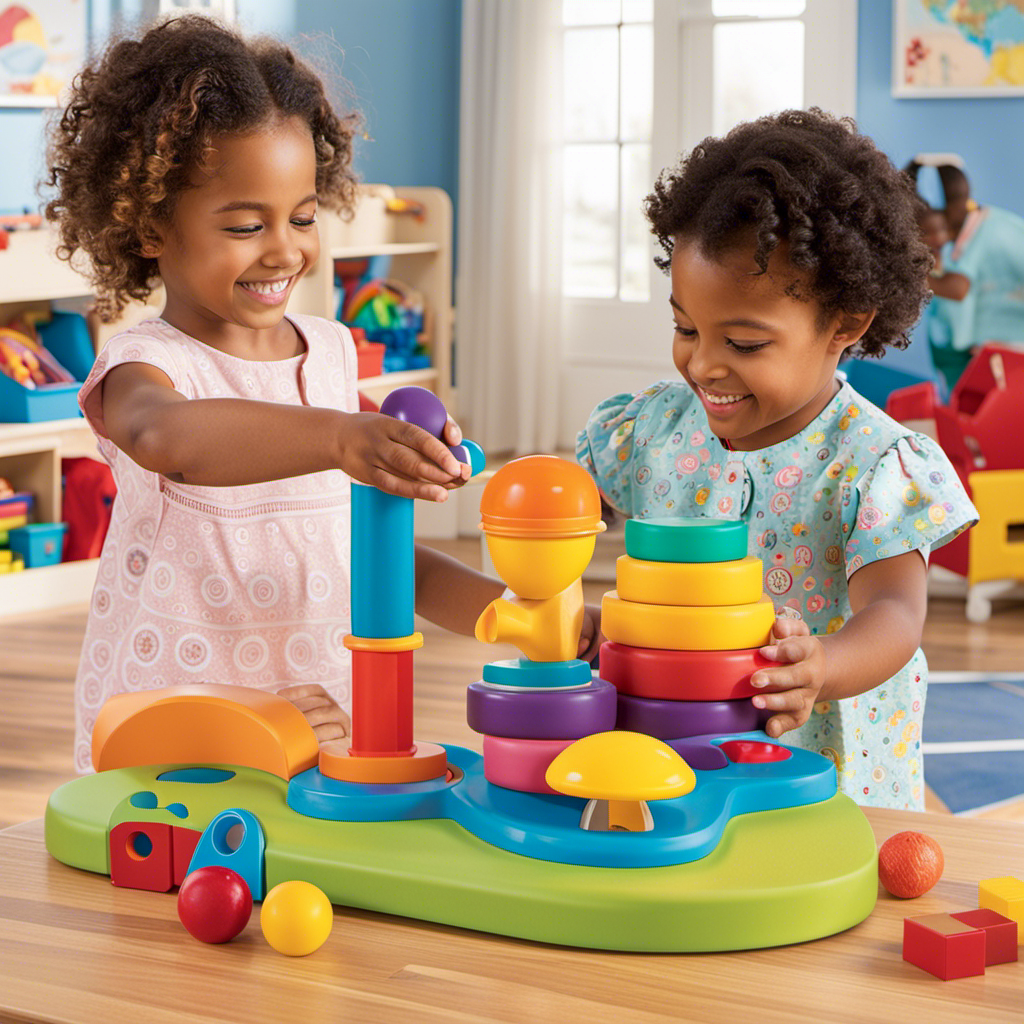
As a parent, I fully grasp the importance of ensuring that educational activities are fun and engaging for young children. That’s why I was thrilled to discover the advantages of educational toys.
These toys not only entertain, but they also seamlessly teach valuable skills. From enhancing cognitive development to building social skills, educational toys offer a hands-on approach to learning.
They encourage problem-solving, critical thinking, and communication skills, all while keeping young minds entertained.
In this article, we will explore the world of toys that teach and discover how they can make learning seamless for preschoolers.
Key Takeaways
- Educational toys for preschoolers provide fun and entertainment while offering cognitive benefits and aiding in sensory development.
- These toys enhance problem-solving skills, stimulate imagination and creativity, and improve cognitive abilities.
- They also promote fine motor skills, support language development, and foster logical thinking.
- Additionally, educational toys for preschoolers help in building social skills, including empathy, cooperation, emotional intelligence, problem-solving, conflict resolution, teamwork, and collaboration abilities.
The Benefits of Educational Toys for Preschoolers
You’ll love the benefits of educational toys for your preschooler. Not only are they fun and entertaining, but they also provide numerous cognitive benefits and aid in sensory development.
These toys are specifically designed to engage your child’s mind and enhance their learning experience. By playing with educational toys, your child can develop essential cognitive skills such as problem-solving, critical thinking, and decision-making. They also stimulate their imagination and creativity, allowing them to explore new ideas and concepts.
Additionally, these toys promote sensory development by engaging your child’s senses of touch, sight, and sound. This helps them to develop their fine motor skills, hand-eye coordination, and spatial awareness.
By providing your child with educational toys, you are giving them the opportunity to learn and grow while having fun.
Now, let’s explore how these toys can further enhance your child’s cognitive development.
How Toys Can Enhance Cognitive Development
Start exploring how playthings can boost cognitive development in young children.
Toys have a profound impact on brain development in preschoolers. Through play-based learning approaches, children can enhance their cognitive skills while having fun. Research shows that toys not only stimulate imagination and creativity, but they also improve problem-solving abilities, memory retention, and language development.
For example, building blocks can enhance spatial awareness and logical thinking, while puzzles can improve critical thinking and problem-solving skills. By engaging in play, children are actively using their brains, making connections, and strengthening neural pathways. As a result, their cognitive abilities are nurtured and expanded.
With this understanding, it is clear that toys play a crucial role in shaping young minds. Now, let’s delve deeper into the power of tactile toys and hands-on learning.
Hands-On Learning: The Power of Tactile Toys
When it comes to children’s toys, the benefits of tactile toys cannot be overstated. These toys engage multiple senses, enhancing sensory development in young children.
From textured blocks to squishy balls, tactile toys provide a hands-on learning experience that promotes exploration and stimulates the senses.
Ultimately, tactile toys support the development of fine motor skills and cognitive abilities.
Benefits of Tactile Toys
Explore the benefits of tactile toys for your preschooler’s learning experience. Tactile toys provide hands-on exploration and sensory stimulation, which are crucial for your child’s development. Here are three reasons why tactile toys are essential for your little one:
-
Enhanced Learning: Tactile toys engage multiple senses, allowing children to experience different textures, shapes, and sizes. This hands-on exploration helps them develop fine motor skills, hand-eye coordination, and cognitive abilities.
-
Creativity and Imagination: Tactile toys encourage imaginative play, as children use their senses to interact with the toys. They can build, stack, and create, fostering their creativity and problem-solving skills.
-
Language Development: Tactile toys promote communication and language skills. As children explore these toys, they engage in conversations, describing what they see, feel, and do. This enhances their vocabulary and expressive language abilities.
Enhancing Sensory Development
Incorporating tactile toys into playtime enhances your child’s sensory development. These toys provide a wonderful opportunity for sensory exploration, allowing your little one to engage their senses and learn about the world around them.
As they touch, feel, and manipulate different textures and shapes, their fine motor skills are also being developed. By grasping and manipulating these toys, they are strengthening the muscles in their hands and fingers, which is crucial for future tasks like writing and drawing.
Tactile toys engage multiple senses at once, creating a rich sensory experience that fosters cognitive development. From soft plush toys to textured blocks, these toys provide endless possibilities for your child to explore and learn.
As they develop their sensory skills, they will also be building a foundation for building social skills through play.
Building Social Skills Through Play
When it comes to building social skills, two key components are role-playing for empathy and cooperation in group activities.
Role-playing allows individuals to step into the shoes of others, helping them develop a deeper understanding and empathy for different perspectives and experiences.
Additionally, engaging in group activities promotes cooperation, teamwork, and effective communication, essential skills for navigating social interactions.
In this discussion, we will explore how role-playing and group activities can foster empathy and cooperation, ultimately enhancing social skills and interpersonal relationships.
Role-Playing for Empathy
Role-playing helps preschoolers develop empathy skills by allowing them to step into the shoes of different characters and understand their feelings and perspectives. Through imaginative play, children can explore different emotions and learn to recognize and respond to the emotions of others. This process of empathy through play is crucial for developing emotional intelligence, which is the ability to understand and manage one’s own emotions and relate to others empathetically.
By engaging in pretend play, children learn to identify and express their own feelings, as well as understand the emotions of their playmates. They can practice problem-solving and conflict resolution, as they navigate different scenarios and negotiate roles and responsibilities. This helps them develop valuable social skills and build strong relationships with their peers.
In addition to fostering empathy, role-playing also sets the stage for cooperation in group activities. By taking on different roles and working together towards a common goal, preschoolers learn the importance of teamwork and collaboration. They learn to communicate effectively, listen to others, and take turns, all essential skills for successful group interactions.
Transitioning from empathy through play to cooperation in group activities, preschoolers can apply the empathy skills they have developed to work together harmoniously and create a positive and inclusive play environment.
Cooperation in Group Activities
By working together in group activities, children can apply their empathy skills to create a positive and inclusive play environment. Group dynamics play a crucial role in developing teamwork skills among preschoolers. When children engage in collaborative activities, they learn how to communicate effectively, share ideas, and work towards a common goal. These experiences teach them the importance of listening to others, compromising, and respecting different perspectives.
Through group activities, children also learn how to navigate conflicts and solve problems together, fostering a sense of unity and cooperation. These skills are essential not only for their social development but also for their future success in school and beyond.
As children develop their cooperation skills, they also lay the foundation for language development: toys that encourage communication.
Language Development: Toys That Encourage Communication
Toys that encourage communication help preschoolers develop their language skills. These toys are specifically designed to promote language development and speech skills in young children. By providing interactive and engaging experiences, these toys create a seamless learning environment where children can practice and enhance their communication abilities.
For example, toys with buttons that speak words or phrases encourage children to mimic and repeat those sounds, helping them build their vocabulary and pronunciation. Additionally, toys that require verbal interaction, such as storytelling or role-playing sets, help children practice expressing themselves and using language in a meaningful way.
These toys not only make learning fun, but they also provide valuable opportunities for preschoolers to develop their language and communication skills.
As preschoolers engage with toys that promote language development, they also have the opportunity to develop their fine motor skills through interactive play.
Developing Fine Motor Skills With Interactive Toys
When it comes to toys, there’s so much more than just fun and games. Toys can actually play a crucial role in a child’s development, helping them learn and grow in various ways.
From boosting their cognitive abilities to improving their motor skills, interactive toys offer a wealth of benefits that go beyond mere entertainment.
In this discussion, we’ll explore how toys can contribute to a child’s overall development, the importance of fun and educational play, and how interactive toys can specifically help in boosting motor skills.
Toy Benefits for Development
You’ll be amazed at how these educational toys can enhance your child’s development. Not only do they provide hours of entertainment, but they also offer numerous benefits for socialization and creativity.
When children engage in play with others, they learn important social skills such as sharing, taking turns, and cooperating. Educational toys that encourage group play, like board games or building sets, can foster these skills in a fun and interactive way.
Additionally, these toys promote creativity through play. Whether it’s a set of art supplies or a pretend play set, children can let their imaginations run wild and express themselves freely. This kind of creative play helps develop problem-solving skills and encourages out-of-the-box thinking.
As we dive into the next section about fun and educational play, you’ll discover even more exciting ways to make learning seamless for your preschooler.
Fun and Educational Play
When it comes to teaching preschoolers, there’s nothing quite like incorporating fun and interactive learning into their playtime. This play-based learning approach not only keeps them engaged, but also helps them develop important skills.
Here are some ways that fun and educational play can benefit preschoolers:
-
Enhances creativity and imagination: Playing with toys that encourage open-ended play allows children to explore their creativity and imagination.
-
Develops problem-solving skills: Toys that involve puzzles or building blocks require children to think critically and find solutions.
-
Improves social skills: Playing with others helps children learn how to share, take turns, and communicate effectively.
-
Builds cognitive skills: Educational toys that focus on letters, numbers, and shapes help children develop their cognitive abilities.
-
Fosters fine motor skills: Toys that involve stacking, sorting, or manipulating objects help improve hand-eye coordination and fine motor skills.
Boosting Motor Skills
Explore activities that involve movement and coordination to help your child boost their motor skills.
Fine motor development is crucial during the preschool years as it lays the foundation for future tasks like handwriting and buttoning shirts.
Encourage your child to engage in activities that require them to use their fingers and hands, such as building blocks, stringing beads, or playing with playdough. These activities not only enhance their fine motor skills but also promote sensory exploration.
Sensory exploration involves using different senses like touch, sight, and hearing to understand the world around them. By providing opportunities for sensory play, such as playing with sand, water, or sensory bins filled with different textured materials, you can further enhance your child’s motor skills and overall development.
Now, let’s move on to math made fun: numeracy toys for preschoolers.
Math Made Fun: Numeracy Toys for Preschoolers
Don’t miss out on the opportunity to make math fun for your preschooler with these engaging numeracy toys. Hands-on learning is crucial for young children, and these interactive math toys provide just that. Here are three fantastic options to consider:
-
Counting Bears: These colorful bears allow your little one to practice counting and sorting. They can also be used for basic addition and subtraction exercises, making math concepts more tangible and enjoyable.
-
Shape Sorter Puzzle: This toy not only helps children recognize and differentiate shapes but also introduces them to basic geometry. By fitting the correct shape into its corresponding slot, kids develop spatial awareness and problem-solving skills.
-
Number Flashcards: These flashcards are a versatile tool for teaching numbers, counting, and basic math operations. They engage visual and auditory senses, making learning more interactive and memorable.
By incorporating these numeracy toys into your child’s playtime, you can foster a love for math and lay a strong foundation for future learning.
Now, let’s explore the world of geography and science toys.
Exploring the World: Geography and Science Toys
You’ll love how these engaging geography and science toys introduce your child to the wonders of the world and spark their curiosity.
Geography puzzles are a fantastic way to teach your little one about the different countries, continents, and landmarks. These puzzles come in various difficulty levels, allowing your child to gradually explore the world at their own pace.
Science experiments are another great tool to help your child learn and understand scientific concepts. From volcano eruptions to growing crystals, these experiments provide hands-on learning experiences that are both fun and educational.
By engaging with geography and science toys, your child will develop a deeper appreciation for the world around them and foster a love for exploration.
Now, let’s dive into how toys can also foster creativity and imagination.
Fostering Creativity and Imagination With Toys
When it comes to fostering creativity and imagination in children, toys play a crucial role.
Through role-playing and storytelling, children can explore different scenarios and develop their own narratives, allowing them to express their ideas and emotions.
Additionally, open-ended play opportunities provide children with the freedom to create and experiment, encouraging them to think outside the box and come up with innovative solutions.
Role-Playing and Storytelling
Role-playing and storytelling are effective ways for preschoolers to learn and develop important skills. These activities encourage children to use their imagination and creativity, allowing them to explore different roles and situations. When children engage in role-playing, they have the opportunity to step into various characters and act out different scenarios. This helps them develop empathy, problem-solving skills, and social interaction skills.
Storytelling, on the other hand, helps children develop their language and communication skills, as well as their ability to think critically and creatively. By creating and narrating stories, children learn to express themselves and develop their own unique ideas.
Both role-playing and storytelling provide endless opportunities for learning and growth. They lay the foundation for open-ended play opportunities, where children can further explore and expand their imagination and creativity.
Open-Ended Play Opportunities
Transitioning from role-playing and storytelling, another important aspect of toys that promote seamless learning for preschoolers is open-ended play opportunities. These play experiences provide children with the freedom to explore, create, and imagine without any set rules or limitations.
Open-ended play allows children to tap into their creativity and problem-solving skills as they engage in unstructured activities. It encourages them to think critically, make decisions, and experiment with different ideas. To illustrate the significance of open-ended play, consider the following table:
| Open-Ended Play Opportunities | Promoting Creativity |
|---|---|
| Building blocks | Painting |
| Playdough | Dress-up |
| Sand and water play | Puppetry |
| Loose parts | Imaginative play |
By integrating these toys into a child’s playtime, they are provided with endless possibilities for exploration and self-expression.
Moving forward, enhancing problem-solving skills is another important aspect of toys that teach preschoolers seamlessly.
Enhancing Problem-Solving Skills
Enhancing problem-solving skills is crucial for young children’s development and can be fostered through engaging activities. By providing children with toys and games that require them to think critically and find solutions, we can improve their decision-making abilities and promote analytical thinking.
For example, puzzles and building blocks encourage children to problem-solve by figuring out how to fit pieces together and create structures. Board games also offer opportunities for strategic thinking and decision-making. Through these activities, children learn to analyze situations, consider different options, and make informed choices. Developing these skills at a young age sets a strong foundation for their future success.
As we explore the importance of problem-solving, it is equally important to consider the role of emotional intelligence: toys that teach empathy.
Emotional Intelligence: Toys That Teach Empathy
Toys that teach empathy help young children understand and connect with others’ emotions. Role playing for empathy is an effective way to cultivate these skills. By engaging in pretend play scenarios with their toys, children can step into different roles and experience various emotions. This allows them to develop a deeper understanding of how others feel and how their actions can impact those around them.
Additionally, cooperation in group activities is another important aspect of fostering empathy. Toys that encourage collaborative play, such as building sets or board games, teach children the value of working together and considering the feelings and perspectives of others. These toys provide opportunities for children to practice empathy in a fun and engaging way.
Transitioning to the next section, problem-solving and critical thinking toys for preschoolers also play a crucial role in their development.
Problem-Solving and Critical Thinking Toys for Preschoolers
In my journey of exploring toys that teach, I have come across a fascinating category of toys that focus on problem-solving and critical thinking skills. These toys are designed to challenge young minds and foster their ability to think analytically and creatively.
Critical thinking puzzles and problem-solving games are excellent tools for preschoolers to develop their cognitive skills while having fun. These toys often present children with puzzles or scenarios that require them to use logic, reasoning, and problem-solving strategies to find a solution.
Whether it’s figuring out the correct sequence of shapes or finding the missing piece of a puzzle, these activities encourage children to think critically and develop their problem-solving abilities. By engaging in these types of activities, preschoolers learn important skills such as logical reasoning, spatial awareness, and pattern recognition.
They also develop patience, perseverance, and the ability to think outside the box.
Transition: Now that we have explored problem-solving and critical thinking toys, let’s delve into the next section about enhancing memory and concentration with educational toys.
Enhancing Memory and Concentration With Educational Toys
Transitioning to the topic of memory and concentration, educational toys provide a fun and effective way for young children to develop these important cognitive skills. Improving focus and memory boosting toys not only engage children in play but also enhance their ability to concentrate and retain information.
These toys are designed to challenge children’s minds, encouraging them to remember patterns, solve puzzles, and think critically. By engaging in play that requires memory and concentration, children are able to strengthen these skills in a natural and enjoyable way.
From memory matching games to puzzles and building blocks, there are a variety of educational toys available that can help children improve their focus and memory.
As we explore the role of technology in preschool learning toys, we will discover how it has revolutionized the way children engage and learn.
The Role of Technology in Preschool Learning Toys
In today’s digital age, technology plays a crucial role in every aspect of our lives, including education. When it comes to preschool learning toys, the integration of technology has revolutionized the way children learn and interact with their toys.
Here are some ways in which technology enhances interactive learning:
-
Engaging multimedia content: Educational toys now come with interactive screens and audio features that make learning more exciting and engaging for preschoolers. They can watch videos, listen to stories, and play games that reinforce their knowledge and skills.
-
Real-world simulations: Technology allows for the creation of virtual environments where children can explore and solve problems. Whether it’s building a virtual city or conducting science experiments, these simulations provide hands-on learning experiences that are both educational and fun.
By incorporating technology into preschool learning toys, children are exposed to a more interactive and immersive learning environment. They can develop essential skills such as problem-solving, critical thinking, and creativity while having a great time.
Now that we understand the role of technology in preschool learning, let’s move on to the next section: choosing the right educational toys for your preschooler.
Choosing the Right Educational Toys for Your Preschooler
When it comes to selecting educational toys for your preschooler, it’s important to consider their interests and developmental needs. Choosing age-appropriate toys can greatly benefit your child’s learning and development.
Hands-on learning is especially beneficial for preschoolers, as it allows them to actively engage with the toy and explore different concepts. These types of toys promote sensory development, fine motor skills, problem-solving abilities, and creativity.
By providing your child with toys that encourage hands-on learning, you are fostering their curiosity and helping them develop important cognitive and physical skills. Look for toys that allow your child to manipulate objects, build structures, solve puzzles, or engage in imaginative play.
Frequently Asked Questions
Are There Any Risks Associated With Using Educational Toys for Preschoolers?
There are potential risks associated with using educational toys for preschoolers, such as small parts that could be choking hazards. It is important to choose toys that are appropriate for their age range to ensure their safety.
How Do Educational Toys Benefit Children With Special Needs?
Using educational toys is like giving wings to children with special needs. These toys provide numerous benefits, such as improving cognitive skills, promoting social interaction, and enhancing sensory development. Inclusive toys are crucial for their holistic growth and learning.
Can Educational Toys Replace Traditional Teaching Methods in Preschool Education?
Educational toys can enhance traditional teaching methods in preschool education. They provide hands-on learning experiences, promote critical thinking, and make learning fun. The impact of educational toys is significant, fostering a love for learning and supporting overall cognitive development.
What Are Some Examples of Educational Toys That Promote Cultural Diversity?
Cultural awareness toys and multilingual playthings are examples of educational toys that promote diversity. They help preschoolers learn about different cultures and languages, fostering a sense of inclusivity and understanding from an early age.
How Can Parents Ensure the Safety of Their Children While Playing With Educational Toys?
As a parent, I prioritize the safety of my child during playtime. To ensure this, I carefully choose age-appropriate toys that are free from small parts, sharp edges, and toxic materials.
Conclusion
In conclusion, educational toys play a vital role in making learning seamless for preschoolers. They offer numerous benefits, such as enhancing cognitive development, building social skills, and promoting language development.
These toys also stimulate problem-solving and critical thinking skills, while improving memory and concentration. With the right educational toys, preschoolers can have fun while learning and preparing for their future.
So, let’s dive into the world of educational toys and watch our little ones soar to new heights of knowledge and imagination. It’s like giving their young minds wings to fly!
Avery brings the magic of words to life at Toddler Ride On Toys. As a dedicated writer, she combines her love for writing with her fascination for child development to craft articles that resonate with our audience. With a background in journalism and a knack for storytelling, Avery’s pieces inform, engage, and inspire parents and caregivers.
Preschool Toys
Tailored Joy: Must-Have Toys for Three-Year-Old Preschoolers
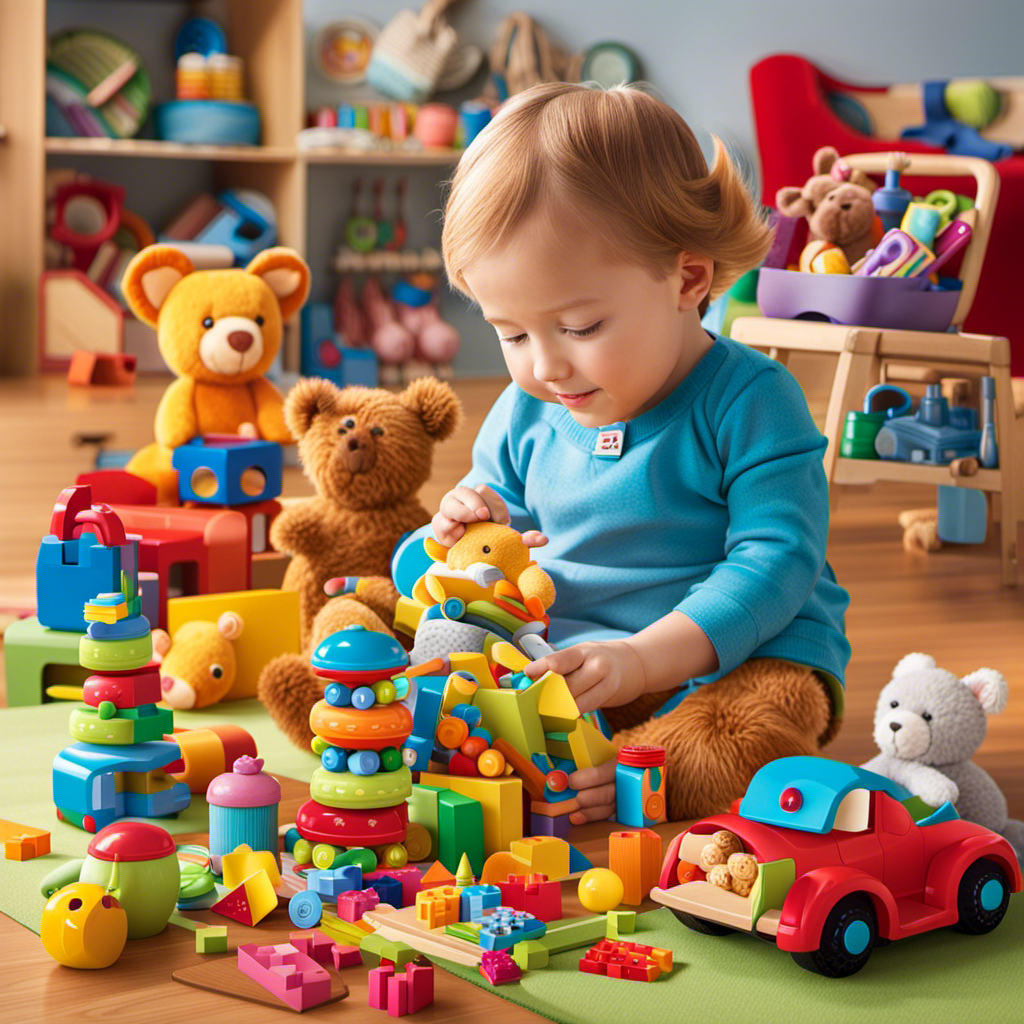
As a parent, I know how challenging it can be to find the perfect toys for my three-year-old child. But don’t worry! In this article, I will guide you through the world of fun, highlighting the must-have toys that will keep your little one happy, engaged, and learning.
From age-appropriate learning toys to imaginative play sets and interactive STEM toys, we’ll explore the best options for your child’s development.
So let’s dive in and discover the joy that awaits!
Key Takeaways
- Sensory exploration toys (building blocks, shape sorters) and cognitive development activities (puzzles, memory games) are important for three-year-old preschoolers as they stimulate thinking and reasoning skills, enhance memory, concentration, and logical thinking abilities.
- Imaginative play sets such as dress up costumes, play kitchen, and dollhouse are essential for three-year-old preschoolers as they foster imagination and social skills, promote imaginative play, fine motor skills, and interest in food, and spark imagination, cognitive development, problem-solving skills, and social interaction.
- Motor skills development toys including fine motor toys (building blocks, puzzles, threading beads) and gross motor toys (ride-on toys, balls, trampolines) are crucial for three-year-old preschoolers as they improve hand-eye coordination and dexterity, develop larger muscle groups, movement, jumping, and balancing, and strengthen muscles, improve coordination, and enhance motor abilities.
- Interactive STEM toys like educational robots (Botley, Dash and Dot) and coding games (Cubetto, Code-a-Pillar) play a significant role in the development of three-year-old preschoolers as they teach coding fundamentals and problem-solving, introduce basic coding concepts in a hands-on manner, and develop cognitive skills, creativity, logical thinking, and perseverance.
Age-Appropriate Learning Toys
Age-appropriate learning toys can help three-year-old preschoolers develop important cognitive and motor skills. Sensory exploration toys, such as building blocks and shape sorters, encourage children to use their senses to explore different textures, colors, and shapes. These toys help develop their fine motor skills, hand-eye coordination, and problem-solving abilities.
Cognitive development activities, such as puzzles and memory games, stimulate their thinking and reasoning skills. These activities enhance their memory, concentration, and logical thinking abilities. By engaging in these age-appropriate learning toys, preschoolers can develop essential skills that will benefit them in their future academic and personal lives.
Now, let’s move on to the next section about imaginative play sets, where preschoolers can unleash their creativity and role-play different scenarios.
Imaginative Play Sets
You’ll love the imaginative play sets for three-year-olds! These toys are designed to encourage creativity and pretend play, allowing children to explore different roles and situations.
Here are three exciting options:
-
Dress up costumes: Dressing up is a favorite activity for young children, and it helps them develop their imagination and social skills. Whether it’s a superhero cape, a princess gown, or a firefighter uniform, dress up costumes allow kids to step into new roles and create their own stories.
-
Play kitchen: A play kitchen is perfect for little aspiring chefs. It comes with miniature pots, pans, and utensils, allowing children to pretend they’re cooking up delicious meals. This type of toy promotes imaginative play, fine motor skills, and encourages an interest in food and nutrition.
-
Dollhouse: A dollhouse is a classic toy that sparks imagination and storytelling. Children can arrange furniture, move the dolls around, and create their own little world. This type of play fosters cognitive development, problem-solving skills, and social interaction.
Now, let’s transition to the next section about motor skills development toys without further ado.
Motor Skills Development Toys
Let’s explore some options for toys that can help children develop their motor skills.
Fine motor toys are designed to improve hand-eye coordination and dexterity. Building blocks, puzzles, and threading beads are excellent choices. These toys require precise movements of the fingers and hands, helping children refine their fine motor skills.
On the other hand, gross motor toys focus on developing larger muscle groups. Ride-on toys, balls, and trampolines encourage children to move, jump, and balance, enhancing their overall physical development.
By engaging in activities that target both fine and gross motor skills, children can strengthen their muscles, improve coordination, and enhance their overall motor abilities.
Now, let’s transition to the next section, where we’ll explore interactive STEM toys that can further stimulate a child’s development.
Interactive STEM Toys
For a child of your age, interactive STEM toys can provide a fun and educational way to explore concepts in science, technology, engineering, and math. These toys are designed to engage young minds and foster critical thinking skills while having a blast.
Educational robots, such as the adorable Botley or the versatile Dash and Dot, teach coding fundamentals and problem-solving through interactive play. Coding games, like the award-winning Cubetto or the engaging Code-a-Pillar, introduce basic coding concepts in a hands-on and age-appropriate manner.
These toys not only develop cognitive skills but also encourage creativity, logical thinking, and perseverance. With interactive STEM toys, children can learn and have fun at the same time, laying a strong foundation for future learning and exploration in these fields.
Now, let’s take a look at some social and emotional learning tools that can further enhance your preschooler’s development.
Social and Emotional Learning Tools
Social and emotional learning tools can be beneficial for young children as they help develop important skills such as self-awareness and empathy. Emotional intelligence activities and social skills building games are effective methods for fostering these skills in preschoolers.
Research has shown that engaging in activities that promote emotional intelligence can lead to better mental health, improved relationships, and increased academic success. For example, games that encourage children to identify and express their emotions help them understand their own feelings and recognize the emotions of others. This builds empathy and strengthens social bonds.
Additionally, social skills building games provide opportunities for children to practice essential skills like turn-taking, sharing, and problem-solving. By incorporating these tools into their playtime, parents and educators can help children develop the necessary emotional and social skills for a successful future.
Frequently Asked Questions
Are There Any Safety Guidelines or Recommendations for Using Age-Appropriate Learning Toys?
I’ve found that safety guidelines and recommendations for age-appropriate learning toys are crucial. It’s important to ensure that the toys are free from small parts, have non-toxic materials, and are age-appropriate to prevent any potential hazards for three-year-old preschoolers.
How Can Imaginative Play Sets Enhance a Child’s Cognitive Development?
Imaginative play sets, like a symphony of creativity, can enhance a child’s cognitive development. They foster problem-solving skills, language development, and social interaction, nurturing their growth and expanding their horizons.
Are There Any Specific Motor Skills Development Toys That Can Help With Fine Motor Skills?
Fine motor skills development toys are essential for three-year-old preschoolers. These toys improve hand-eye coordination and promote the growth of small muscles in the hands and fingers. They are the best tools for enhancing fine motor skills.
What Are Some Examples of Interactive STEM Toys That Can Promote Problem-Solving Skills?
Interactive STEM toys provide engaging ways for three-year-old preschoolers to develop problem-solving skills. These toys not only entertain but also stimulate critical thinking and creativity, fostering a love for learning at an early age.
How Can Social and Emotional Learning Tools Benefit a Three-Year-Old’s Overall Development?
Social and emotional learning tools play a crucial role in a three-year-old’s overall development. They help children develop self-awareness, empathy, and problem-solving skills, which are essential for building positive relationships and navigating emotions.
Conclusion
In conclusion, it’s crucial to provide three-year-old preschoolers with age-appropriate toys that promote their learning and development. Research shows that 90% of brain development occurs by the age of five, making this a critical period for learning.
By choosing toys that stimulate their imagination, enhance motor skills, and introduce STEM concepts, we can ensure that our little ones are well-prepared for the future.
Additionally, incorporating social and emotional learning tools into their playtime can help them develop important life skills.
So let’s make playtime educational and enjoyable for our three-year-olds!
Avery brings the magic of words to life at Toddler Ride On Toys. As a dedicated writer, she combines her love for writing with her fascination for child development to craft articles that resonate with our audience. With a background in journalism and a knack for storytelling, Avery’s pieces inform, engage, and inspire parents and caregivers.
-

 Preschool Toys2 months ago
Preschool Toys2 months agoTop 8 Interactive Role-Play Toys for Preschoolers Reviewed
-

 Child Development3 months ago
Child Development3 months agoWhat Do You Do in Child Development Class in High School
-

 Child Development3 months ago
Child Development3 months agoWhat Is a Theory in Child Development
-

 Waldorf Toys3 months ago
Waldorf Toys3 months agoTwos and Toys: Waldorf Selections Perfect for Two-Year-Olds
-

 Child Development3 months ago
Child Development3 months agoHow Parenting Styles Affect Child Development
-

 Child Development3 months ago
Child Development3 months agoThe Science Behind How Parents Affect Child Development
-

 Child Development3 months ago
Child Development3 months agoHow Does Piaget’s Theory Impact Child Development
-
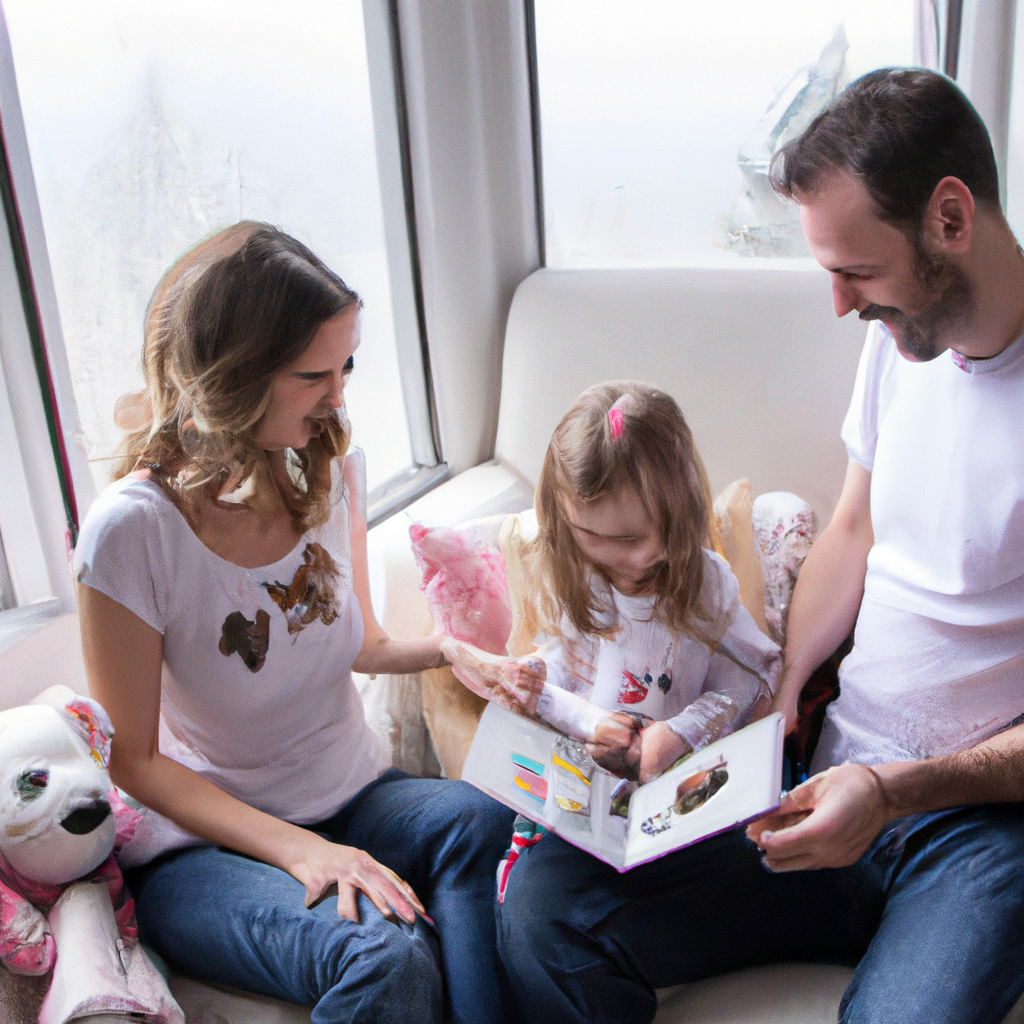
 Child Development3 months ago
Child Development3 months agoWhat Are Protective Factors in Child Development








